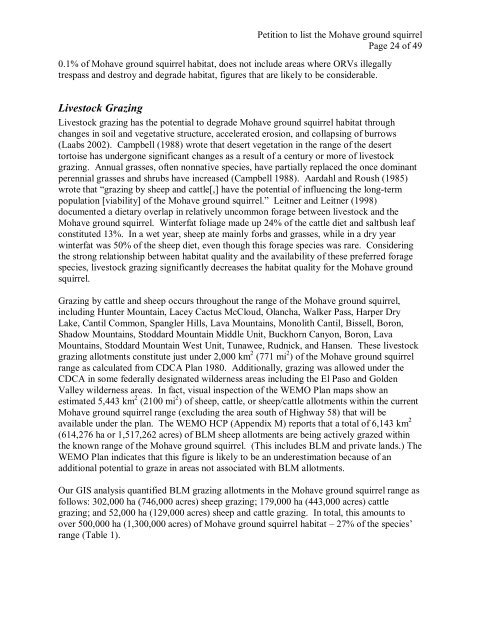Petition to list the Mohave Ground Squirrel - Defenders of Wildlife
Petition to list the Mohave Ground Squirrel - Defenders of Wildlife
Petition to list the Mohave Ground Squirrel - Defenders of Wildlife
You also want an ePaper? Increase the reach of your titles
YUMPU automatically turns print PDFs into web optimized ePapers that Google loves.
<strong>Petition</strong> <strong>to</strong> <strong>list</strong> <strong>the</strong> <strong>Mohave</strong> ground squirrel<br />
Page 24 <strong>of</strong> 49<br />
0.1% <strong>of</strong> <strong>Mohave</strong> ground squirrel habitat, does not include areas where ORVs illegally<br />
trespass and destroy and degrade habitat, figures that are likely <strong>to</strong> be considerable.<br />
Lives<strong>to</strong>ck Grazing<br />
Lives<strong>to</strong>ck grazing has <strong>the</strong> potential <strong>to</strong> degrade <strong>Mohave</strong> ground squirrel habitat through<br />
changes in soil and vegetative structure, accelerated erosion, and collapsing <strong>of</strong> burrows<br />
(Laabs 2002). Campbell (1988) wrote that desert vegetation in <strong>the</strong> range <strong>of</strong> <strong>the</strong> desert<br />
<strong>to</strong>r<strong>to</strong>ise has undergone significant changes as a result <strong>of</strong> a century or more <strong>of</strong> lives<strong>to</strong>ck<br />
grazing. Annual grasses, <strong>of</strong>ten nonnative species, have partially replaced <strong>the</strong> once dominant<br />
perennial grasses and shrubs have increased (Campbell 1988). Aardahl and Roush (1985)<br />
wrote that “grazing by sheep and cattle[,] have <strong>the</strong> potential <strong>of</strong> influencing <strong>the</strong> long-term<br />
population [viability] <strong>of</strong> <strong>the</strong> <strong>Mohave</strong> ground squirrel.” Leitner and Leitner (1998)<br />
documented a dietary overlap in relatively uncommon forage between lives<strong>to</strong>ck and <strong>the</strong><br />
<strong>Mohave</strong> ground squirrel. Winterfat foliage made up 24% <strong>of</strong> <strong>the</strong> cattle diet and saltbush leaf<br />
constituted 13%. In a wet year, sheep ate mainly forbs and grasses, while in a dry year<br />
winterfat was 50% <strong>of</strong> <strong>the</strong> sheep diet, even though this forage species was rare. Considering<br />
<strong>the</strong> strong relationship between habitat quality and <strong>the</strong> availability <strong>of</strong> <strong>the</strong>se preferred forage<br />
species, lives<strong>to</strong>ck grazing significantly decreases <strong>the</strong> habitat quality for <strong>the</strong> <strong>Mohave</strong> ground<br />
squirrel.<br />
Grazing by cattle and sheep occurs throughout <strong>the</strong> range <strong>of</strong> <strong>the</strong> <strong>Mohave</strong> ground squirrel,<br />
including Hunter Mountain, Lacey Cactus McCloud, Olancha, Walker Pass, Harper Dry<br />
Lake, Cantil Common, Spangler Hills, Lava Mountains, Monolith Cantil, Bissell, Boron,<br />
Shadow Mountains, S<strong>to</strong>ddard Mountain Middle Unit, Buckhorn Canyon, Boron, Lava<br />
Mountains, S<strong>to</strong>ddard Mountain West Unit, Tunawee, Rudnick, and Hansen. These lives<strong>to</strong>ck<br />
grazing allotments constitute just under 2,000 km 2 (771 mi 2 ) <strong>of</strong> <strong>the</strong> <strong>Mohave</strong> ground squirrel<br />
range as calculated from CDCA Plan 1980. Additionally, grazing was allowed under <strong>the</strong><br />
CDCA in some federally designated wilderness areas including <strong>the</strong> El Paso and Golden<br />
Valley wilderness areas. In fact, visual inspection <strong>of</strong> <strong>the</strong> WEMO Plan maps show an<br />
estimated 5,443 km 2 (2100 mi 2 ) <strong>of</strong> sheep, cattle, or sheep/cattle allotments within <strong>the</strong> current<br />
<strong>Mohave</strong> ground squirrel range (excluding <strong>the</strong> area south <strong>of</strong> Highway 58) that will be<br />
available under <strong>the</strong> plan. The WEMO HCP (Appendix M) reports that a <strong>to</strong>tal <strong>of</strong> 6,143 km 2<br />
(614,276 ha or 1,517,262 acres) <strong>of</strong> BLM sheep allotments are being actively grazed within<br />
<strong>the</strong> known range <strong>of</strong> <strong>the</strong> <strong>Mohave</strong> ground squirrel. (This includes BLM and private lands.) The<br />
WEMO Plan indicates that this figure is likely <strong>to</strong> be an underestimation because <strong>of</strong> an<br />
additional potential <strong>to</strong> graze in areas not associated with BLM allotments.<br />
Our GIS analysis quantified BLM grazing allotments in <strong>the</strong> <strong>Mohave</strong> ground squirrel range as<br />
follows: 302,000 ha (746,000 acres) sheep grazing; 179,000 ha (443,000 acres) cattle<br />
grazing; and 52,000 ha (129,000 acres) sheep and cattle grazing. In <strong>to</strong>tal, this amounts <strong>to</strong><br />
over 500,000 ha (1,300,000 acres) <strong>of</strong> <strong>Mohave</strong> ground squirrel habitat – 27% <strong>of</strong> <strong>the</strong> species’<br />
range (Table 1).
















